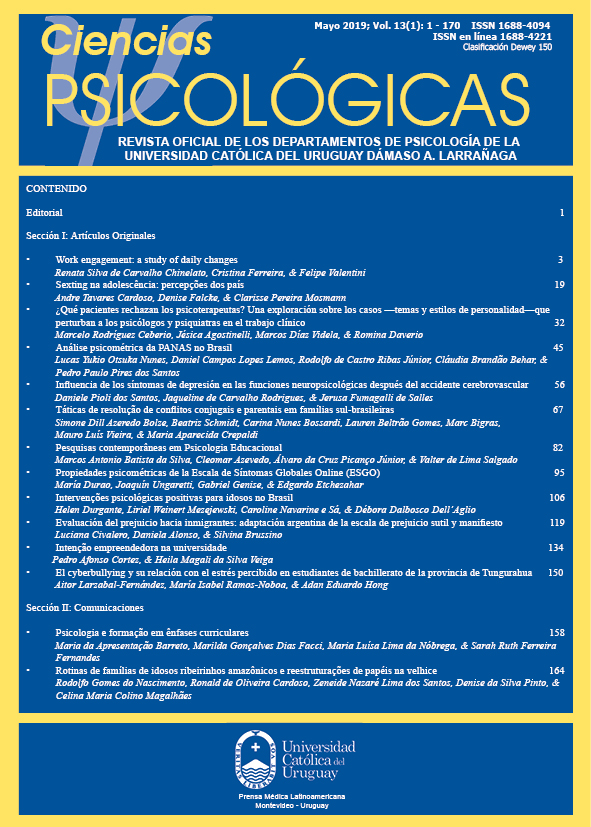What patients reject psychotherapists? An exploration of the cases - themes and personality styles - that disturb psychologists and psychiatrists in clinical work
DOI:
https://doi.org/10.22235/cp.v13i1.1807Keywords:
gender, patients, professional practice, psychotherapy, therapeutic styleAbstract
Although the therapeutic model is relevant in order to provide theoretical constructions that allow conceiving human problems from a particular perspective, its practical application goes through the sieve of the personal characteristics of the therapist and the particularities of the context where the model is exercised. Thus, beliefs, values, history, personality traits of the therapist modify the model, in the same way as the attention in a private practice or public hospital or the characteristics or themes of the patient. Therefore, beyond the model, it is important to talk about the "therapeutic style". Within the personal limitations that modify the model are certain patient characteristics and subjects that disturb the therapist in his free exercise. The aim of this work is to explore what are the issues (stories and problems) and the characteristics (personality traits and pathology) of the patients that generate rejection of Argentine psychotherapists (psychologists and psychiatrists), taking into account other variables such as years of professional exercise, attention area, gender and therapeutic model. A transversal and descriptive-correlational study was carried out through surveys. The main results were that the subjects that generated absolute rejection in the therapists were the torturers, abusers, murderers and criminals.
Downloads
References
Baranger, W. (1982). Los afectos en la contratransferencia. En Introducción a los paneles, XIV Congreso Psicoanalítico de América Latina. Buenos Aires.
Barreto, P., & Bayes, R. (1990). El psicólogo ante el enfermo en situación terminal. Anales de psicología, 6(2), 169-180.
Belisario, S. (1996). Actitudes del profesional de la salud hacia los pacientes con SIDA. Revista de la facultad de medicina, Universidad de Los Andes, 5(1-4), 39-43.
Bleger, J. (1964). Temas de Psicología. Entrevista y grupos. Bs. As: Nueva Visión.
Ceberio, M. R. (2013a). Nuevas estructuras familiares, nuevos desafíos terapéuticos. Viejas y nuevas familias. En M. R. Ceberio & H. Serebrinsky (Eds.), Dentro y fuera de la caja negra. Buenos Aires: Psicolibro.
Ceberio, M. R. (2013b). El cielo puede esperar. La 4ta edad: ser anciano en el siglo XXI. Madrid: Morata.
Ceberio, M. R., & Linares, J. L. (2005). Ser y hacer en terapia sistémica. La construcción del estilo terapéutico. Barcelona: Paidós.
Ceberio, M. R., Medina, R. & Linares, J. L. (Eds). (2007). Terapia familiar en Iberoamérica. Buenos Aires: Tres Haches.
Cesio, F. R. (1963). La comunicación extraverbal en psicoanálisis. Transferencia, contratransferencia e interpretación. Revista de psicoanálisis, 20(2), 124-127.
Elkaim, M. (1992). Si me amas, no me ames: psicoterapia con enfoque sistémico. Barcelona: Gedisa.
Fernández Alvarez, H. (1996). Características del psicoterapeuta. Revista Dinámica, 1(4), 1-24.
Freud, S. (2001). 1915-Puntualizaciones sobre el amor de transferencia. Obras completas, 12, 159-173. Buenos Aires: Amorrortu.
Von Glasersfeld, E. (1988). Introducción al constructivismo radical. En Watzlawick, P. (Ed.), La realidad inventada. Barcelona: Gedisa.
Keeney, B. (1983). Aesthetic of Change. Nueva York: The Guilford Press. Versión cast. (1987). Estética del cambio. Barcelona: Paidós.
Keeney, B. (1990). Improvisational Therapy. A practical guide for creative clinical strategies. Minnesotta: Systemic Therapy Press. Versión cast. (1992). La improvisación en psicoterapia. Guía práctica para estrategias clínicas creativas. Barcelona: Paidós.
Kerman, B. (Eds.). (2014). Nuevas ciencias de la conducta. Buenos Aires: Editorial de la Universidad de Flores.
Laplanche, J., & Pontalis, J. (1985) Diccionario de Psicoanálisis. Barcelona: Labor.
León, O. G., & Montero, I. (2002). Métodos de investigación en Psicología y Educación. Madrid: McGraw-Hill.
Martínez Gómez, E., Moral de la Rubia, J. & Valle de la O, A. (2013). Evaluación del rechazo hacia la homosexualidad en estudiantes de medicina y psicología con base en tres escalas conceptuales a fines. Psicología desde el Caribe, 30(3), 526-550.
Pereira Tercero, R. (2010). Evolución y diagnóstico del duelo normal y patológico. Formación Médica Continuada en Atención Primaria, 17(10), 656-663.
Pichon Riviere, E. (1995) Diccionario de términos y conceptos de Psicología y Psicología social. Buenos Aires: Nueva Visión.
Pope, K. S., & Vasquez, M. J. (2016). Ethics in psychotherapy and counseling: A practical guide. John Wiley & Sons.
Rosenbaum, M. (Ed.). (1985). Ética y valores en psicoterapia. Fondo de Cultura Económica.
Selvini Palazzoli, M. (1989). Paradosso e contraparadosso. Un nuovo modelo nella terapia della famiglia a transazione schizofrénica. Milan: Feltrinelli. Versión cast. (1988) Paradoja y Paradoja. Un nuevo modelo en la terapia de la familia de transacción esquizofrénica. Barcelona: Paidós.
Urban, J. (2017). De la Contratransferencia a las Resonancias: Las emociones del profesional en psicoterapia. Revista de Psicoterapia, 28(108), 229-247.
Verdier, P. (1997). Ética y psicoterapia. Cuadernos de Bioética, 2.


















